Waves, sound and light: Identify and critically evaluate the impact of geometrical optics on human development
Unit 2: The uses of lenses
Dylan Busa
Unit 2 outcomes
By the end of this unit you will be able to:
- Apply knowledge of convergence and divergence to spectacles and the correction of lens defects in the eye.
- Apply knowledge of convergence and divergence to the use of lenses in telescopes, microscopes and cameras.
Refer back to unit 1 if you need hep with this.
What you should know
Before you start this unit, make sure you can:
- Construct and interpret diagrams of an image formed by a converging (convex) lens.
- Construct and interpret diagrams of an image formed by a diverging (concave) lens.
Introduction
Lenses have changed the world! From the revolutions in science, culture and religion brought about by Galileo and his telescope in the 16th century (see figure 1) to the more recent breakthroughs in chemistry, biology, genetics and medicine due to microscopy and the use of microscopes (see figure 2), lenses have played an enormous role in humankind’s development and progress. This is not to mention the many millions of people whose lives have been greatly improved because of glasses, also called spectacles.
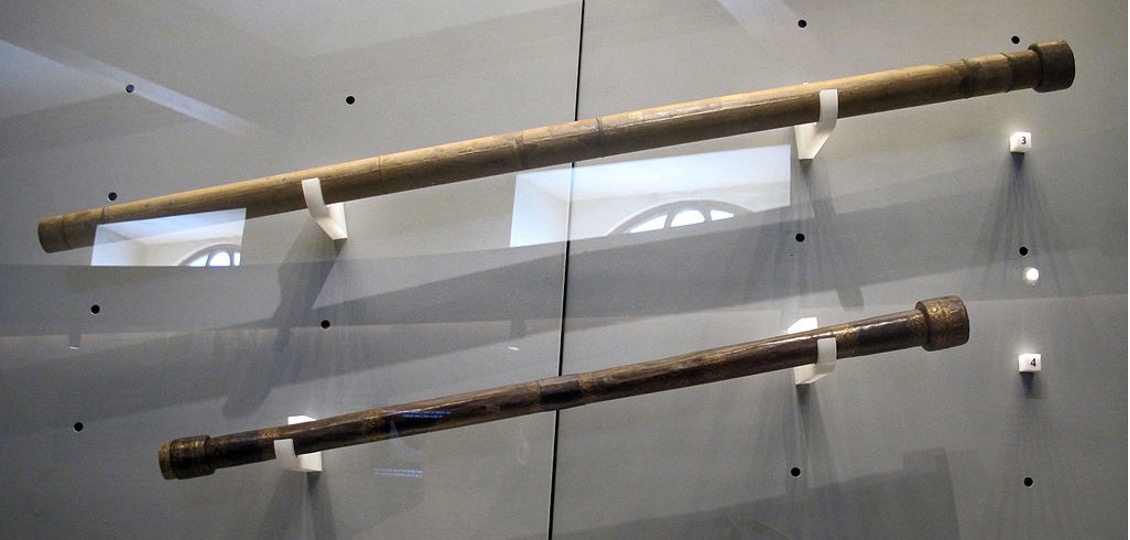
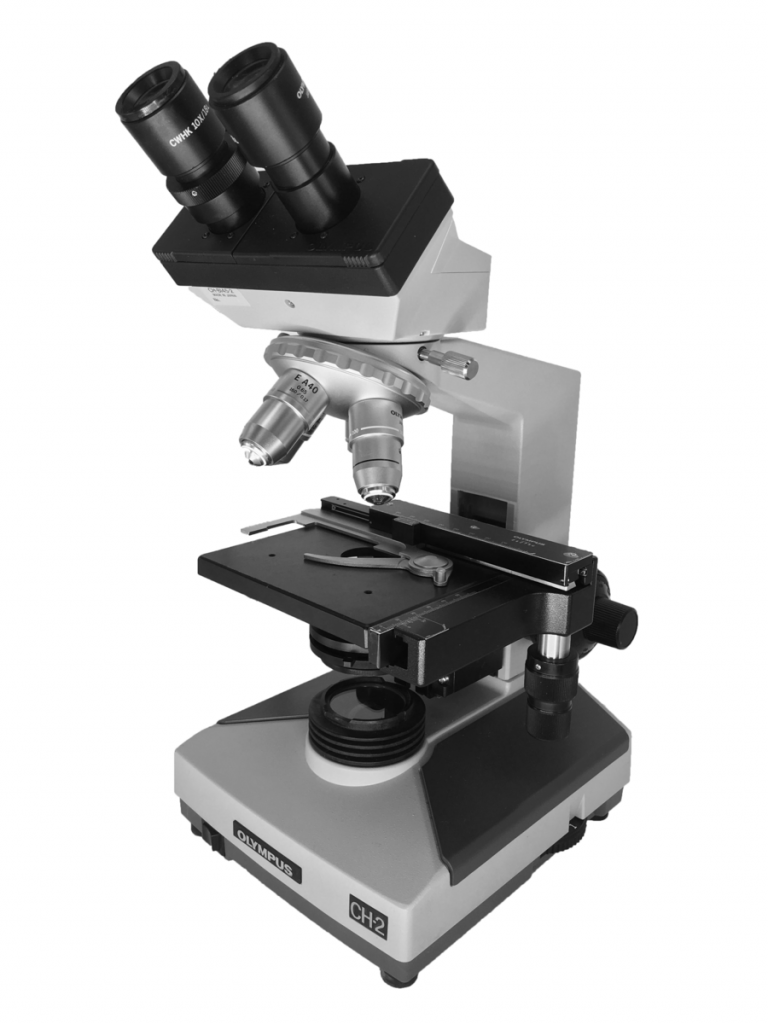
When we think of lenses, we usually think of optical lenses, those made of glass or other high-tech plastic . However, lenses can also be magnetic fields like those used to focus beams of electrons in electron microscopes. Lenses can also be as simple as a satellite dish that focus all the radio waves captured by the dish to a single point. There are even acoustic lenses – devices that refract and focus sound waves. Any physical object that bends or refracts waves in predictable and useful ways can be considered a lens and their action is often termed lensing. Even planets and whole galaxies exert a lensing effect on light travelling through space.
Did you know?
One building in London’s financial district, nicknamed the ‘Walkie-Talkie’ for its shape (see figure 3), has the effect of focusing the sun’s rays on a particular part of a nearby street so effectively that the resulting heat can melt the road and cars parked in the road.

If you would like to learn more about this amazing story, you can watch the video called UK building melts cars.
Lenses and the eye
A common use of lenses is in spectacles (the glasses that people wear to correct problems with their vision). To understand what these problems are and how lenses are used to correct them, we need to first understand how the eye works.
How the eye works
The following description of how the eye works is adapted from OpenStax Physics Chapter 26: Vision and optical instruments.
The eye is remarkable in how it works, especially in terms of the richness of detail and colour it can detect.
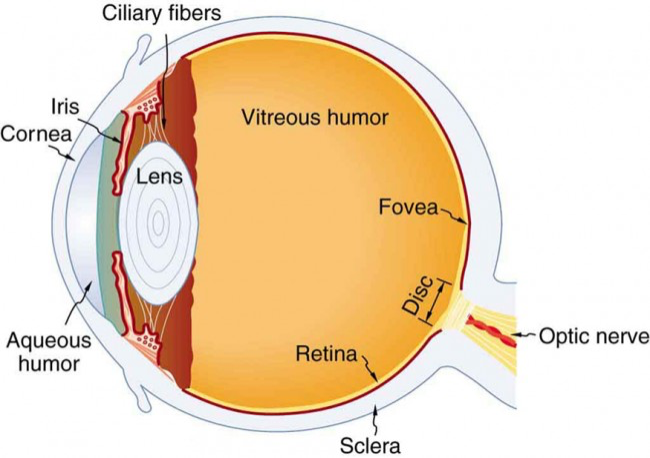
Figure 4 shows the basic anatomy of the human eye. The cornea and lens form a system that, basically, acts as a single, thin, convex lens. For clear vision, a real image must be projected onto the light-sensitive retina at the back of the eye. This lies at a fixed distance from the lens. Therefore, the focal length of the system needs to be changed. While the cornea actually accounts for the majority of the refraction in this system, it is hard, and its shape cannot be changed.
Therefore, the curvature (and hence power) of the lens is adjusted to produce an image on the retina for objects at different distances. The centre of the image falls on the fovea, which has the greatest density of light receptors and the greatest in the visual field. The optic nerve conveys signals received by the eye to the brain where they are processed and understood.
Figure 5 shows how the eye refracts light from an object to create a real image on the retina.
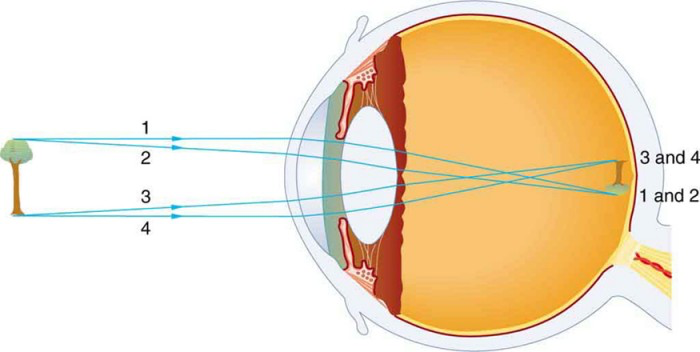
The human eye can see objects from [latex]\scriptsize 25~\text{cm}[/latex] in front of us to practically an infinite distance away. The process of adjusting the eye’s focal length is called accommodation. For distant objects, the lens is relaxed, which reduces its curvature and power. Light rays from very far objects enter the eye essentially parallel to each other and so need a less powerful lens ([latex]\scriptsize P[/latex]) to make them converge on the retina (see figure 6).
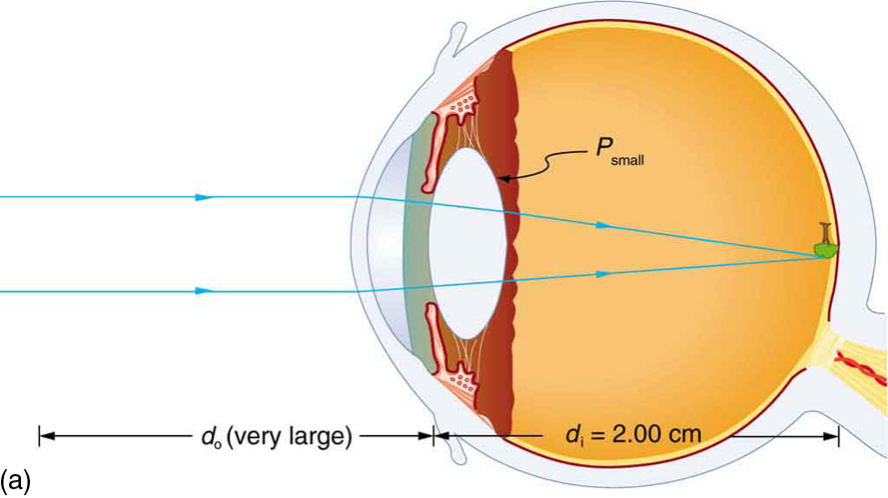
However, for nearby objects, light rays will tend to enter the eye diverging from each other, and so the eye increases the curvature and power ([latex]\scriptsize P[/latex]) of the lens to converge these rays onto the retina (see figure 7).
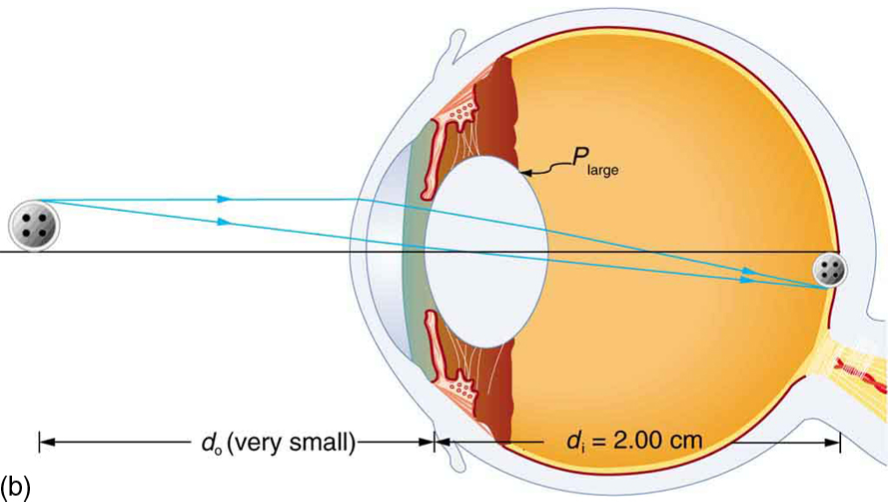
Note
For a more detailed explanation of how the eye works watch the video called How the Eye Functions. It is old and a bit long but fascinating.
Vision correction
As we age, the lens becomes less elastic and less able to accommodate objects at different distances. We need spectacles to correct for this. For other people, their eyeballs are either too short or too long, meaning that the lenses are not able to accommodate sufficiently to see objects at some distances clearly.
There are two basic types of vision problems:
- Near-sightedness or myopia is the inability to see distant objects clearly while close objects are clear.
- Far-sightedness of hyperopia is the inability to see near objects clearly while distant objects are clear.
Figure 8 illustrates the main causes of myopia and hyperopia.
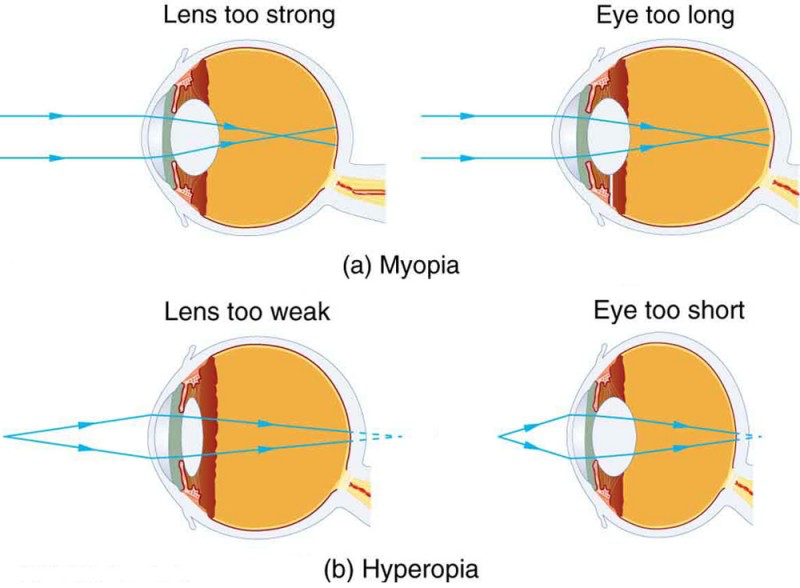
Before reading on, think for a moment how you think each of these problems could be corrected. What kind of lens needs to be placed in front of the eye? Look at figure 8 again to see what problem needs to be resolved.
Because a near-sighted eye converges light rays too much, the correction for myopia is to place a diverging lens in front of the eye (see figure 9). This reduces the power of the eye’s lens.
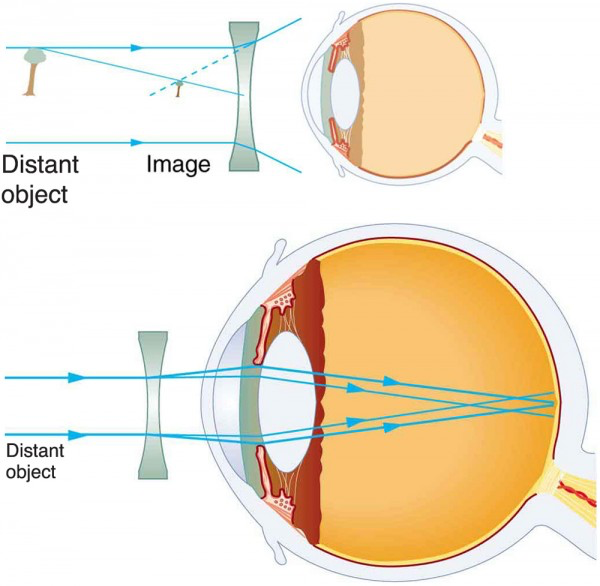
You can think of this another way. A diverging lens means that the object viewed by the eye is perceived by the eye as being nearer than it actually is. To determine the power of the diverging lens needed, you need to know the person’s far point – the greatest distance at which they can see clearly. The spectacle lens needs to be such that the image produced by it must be at this distance or closer for the near-sighted person to be able to see it clearly.
Because a far-sighted eye under converges, the correction for hyperopia is to place a converging lens in front of the eye to increase the power of an eye (see figure 10).
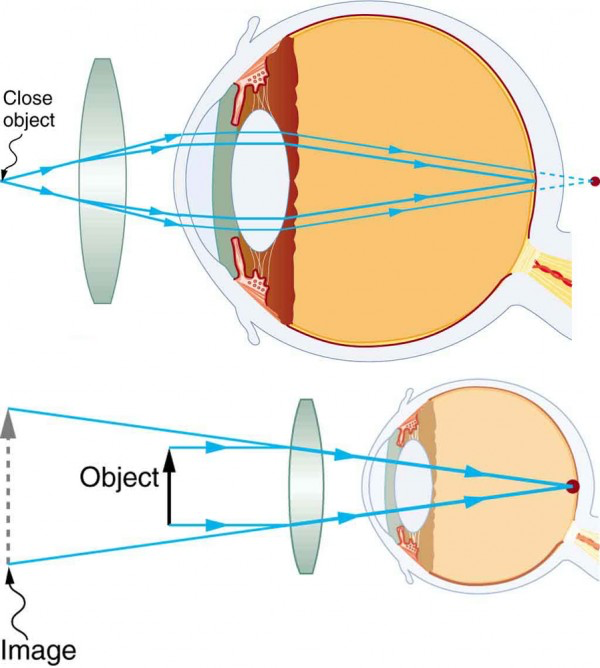
You can think of this another way. A converging lens means that the object viewed by the eye is perceived by the eye as being further away than it actually is. To determine the power of the converging lens needed, you need to know the person’s near point – the smallest distance at which they can see clearly. The spectacle lens needs to be such that the image produced by it must be at this distance or further for the far-sighted person to be able to see it clearly.
People who experience both myopia and hyperopia may sometimes choose to wear bifocal spectacles instead of carrying around two pairs of glasses. Part of the lens corrects for myopia and the other part corrects for hyperopia.
Note
If you have an internet connection, spend some time playing with the Optics of the human eye interactive simulation.
Here you can simulate myopia and hyperopia as well as the correction of these conditions.
Astigmatism
Another common eye problem is called astigmatism and is the result of an unevenness or asymmetry in the eye. This means that different parts of the lens system produce images at slightly different locations depending on the direction from which the light enters the eye. The brain can compensate for some of this but, after a point, the person will see some images as elongated or images along certain axes being clearer than others.
Have a look at figure 11. Check each of your eyes separately by looking at the centre cross (without spectacles if you wear them). If lines along some axes appear darker or clearer than others, you may have an astigmatism.
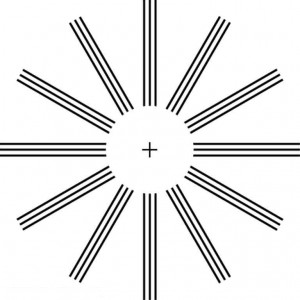
Did you know?
Some types of astigmatism as well as myopia and hyperopia can be corrected with laser eye surgery. This surgery uses tiny lasers to correct vision problems by changing the shape of the cornea itself, rather than placing a corrective lens in front of the eye. Remember the cornea accounts for most of the refractive power in the cornea/lens system.
The small and far
As amazing as human sight is, it does have its limits. For example, if you look at a full moon on a clear night, you can see some detail but definitely not all. You also cannot see objects smaller than about [latex]\scriptsize 0.1~\text{mm}[/latex] with your naked (or unaided eye). To help us see objects very far away in more detail and to see things that are really small, we have invented telescopes and microscopes.
Microscopes
The first microscopes were invented in the 1600s and the basic design has not changed that much since. Most microscopes are compound microscopes. They have two convex lenses – an objective lens and an eyepiece lens (see figure 12). The image formed by the objective lens becomes the object for the eyepiece lens. With this simple arrangement, microscopes can achieve magnifications of [latex]\scriptsize 1~500~\text{X}[/latex] and higher and can help us see objects that are about [latex]\scriptsize 0.2~\mu\text{m}[/latex] big.
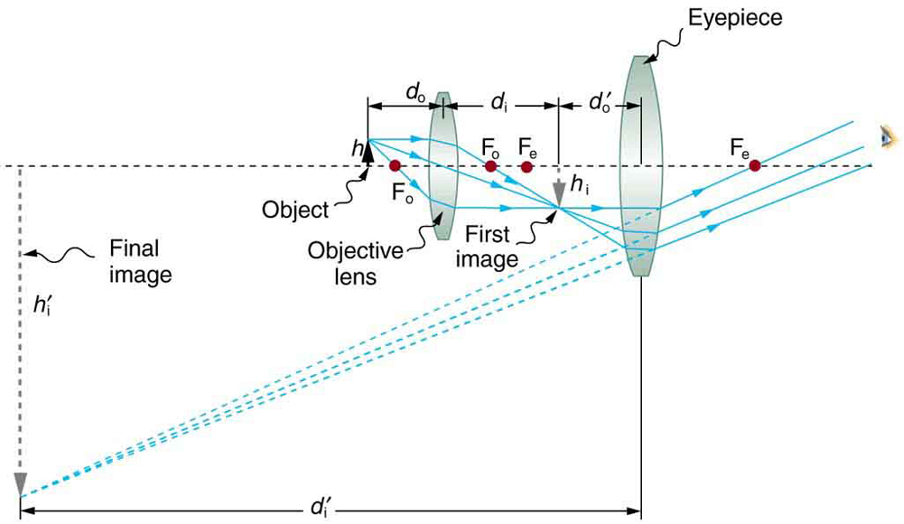
The object is placed just beyond the objective lens’ focal point ([latex]\scriptsize f_o[/latex] in figure 12). This lens therefore forms a real image that is inverted and magnified. If you recall from the previous unit, this is the ‘Between [latex]\scriptsize 2F[/latex] and [latex]\scriptsize F[/latex]’ case. This image becomes the object for the eyepiece lens. The eyepiece lens is designed and positioned so that this object is closer to it than its focal length ([latex]\scriptsize f_e[/latex] in figure 12). The image formed is therefore, virtual, non-inverted and magnified. In this case, the eyepiece lens is acting as an ordinary magnifying glass.
Note
For a more detailed look at how a compound microscope works, watch the video called Compound microscope.
The total magnification of the system is the product of the magnifications of each lens i.e. [latex]\scriptsize m=m_o\times m_e[/latex].
Note
If you have an internet connection, spend some time using a virtual microscope in a lab to see whether a sample of yoghurt has been contaminated with harmful bacteria. This virtual lab will give you a sense of how microscopes are used in real laboratories.
Take note!
The overall magnification of any multiple-element system is the product of the individual magnifications of its elements. In the case of a compound microscope this is [latex]\scriptsize m=m_o\times m_e[/latex].
Telescopes
The earliest telescopes had two lenses. Most had a convex objective lens and a concave eyepiece lens (see figure 13). The telescopes constructed by Galileo were of this type. The diverging (concave) eyepiece lens resulted in an upright or non-inverted final image and so this is the design still used today for spyglasses and opera glasses.

Many camera lenses still use this basic arrangement today. More modern telescope designs use a compound system of two convex lenses (like a microscope), but this results in an inverted final image (see figure 14). For looking at the stars, this is not a problem.
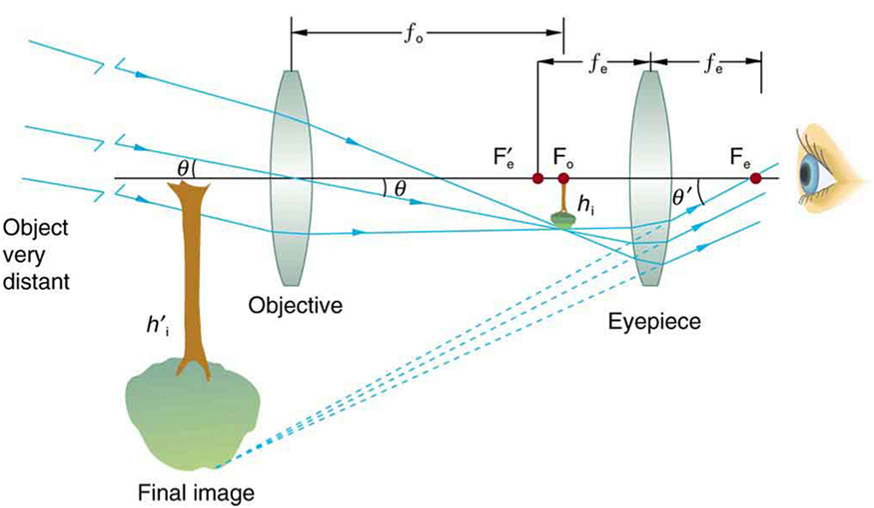
Figure 14 illustrates, by way of a ray diagram, how a modern telescope (sometimes called an astronomical telescope) works. Because the object is very far away, we can assume that a real, reduced, inverted image is formed at the focal length of the objective lens. This image becomes the object for the eyepiece lens. If this object is placed less than the eyepiece lens’ focal length away from the eyepiece lens, then a virtual, magnified and upright or non-inverted image is formed. In other words, the objective lens brings the distant object closer and then the eyepiece lens works like an ordinary magnifying glass.
Note
For a more detailed description of how astronomical telescopes work watch the video called How telescopes work.
For applications such as ship telescopes and gun sights, the inverted image that results from the two convex lens design is a problem. In these cases, a third convex lens is used re-invert the image (see figure 15).
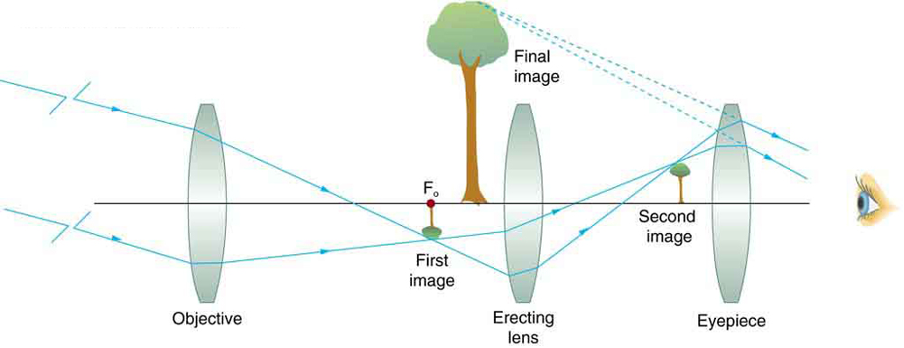
Summary
In this unit you have learnt the following:
- Short-sightedness or myopia occurs when a person is only able to see near objects. They cannot focus on distant objects.
- Myopia is corrected by reducing the power of the lens with a diverging lens.
- Far-sightedness or hyperopia occurs when a person is only able to see distant objects. They cannot focus on near objects.
- Hyperopia is corrected by increasing the power of the lens with a converging lens.
- Compound microscopes use two convex lenses. The objective lens serves to create a real, inverted and magnified image that becomes the object for the eyepiece lens which acts like a normal magnifying glass.
- Telescopes use a variety of designs but the common astronomical telescope is very similar in design and operation to the microscope. The objective lens forms a real, inverted and magnified image which becomes the object for the eyepiece lens which acts like a normal magnifying glass.
Unit 2: Assessment
Suggested time to complete: 20 minutes
- What type of lens can be used to correct short-sightedness? Draw a simple ray diagram to illustrate your answer. Include rays for the corrected and uncorrected condition.
- What type of lens can be used to correct long-sightedness? Draw a simple ray diagram to illustrate your answer. Include rays for the corrected and uncorrected condition.
- What type of image is formed by the lens system in a compound microscope? Draw a ray diagram to explain how a compound microscope works.
The full solutions can be found at the end of the unit.
Unit 2: Solutions
Unit 2: Assessment
- A diverging lens is used to correct short-sightedness.
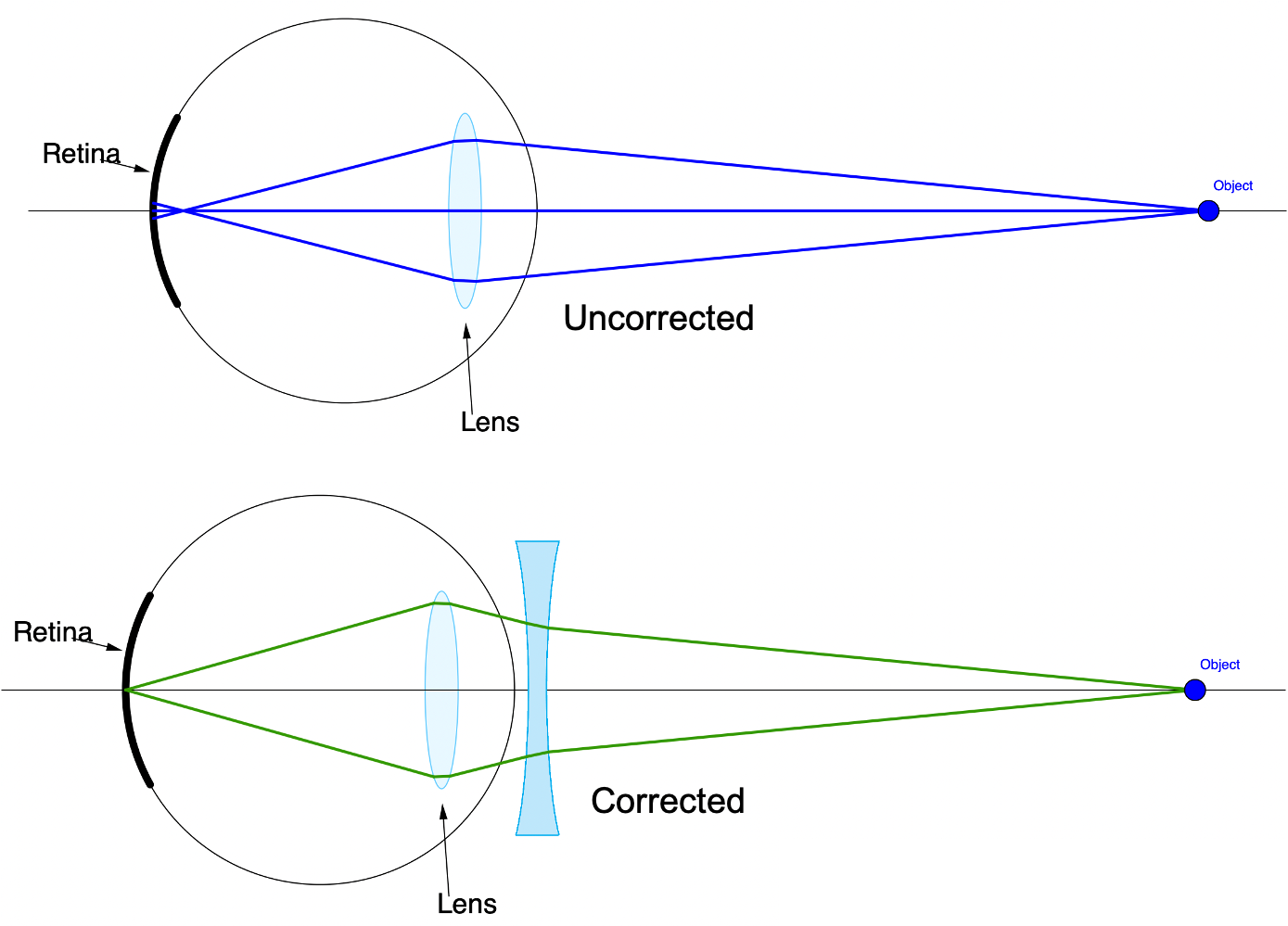
- A converging lens is used to correct far-sightedness.
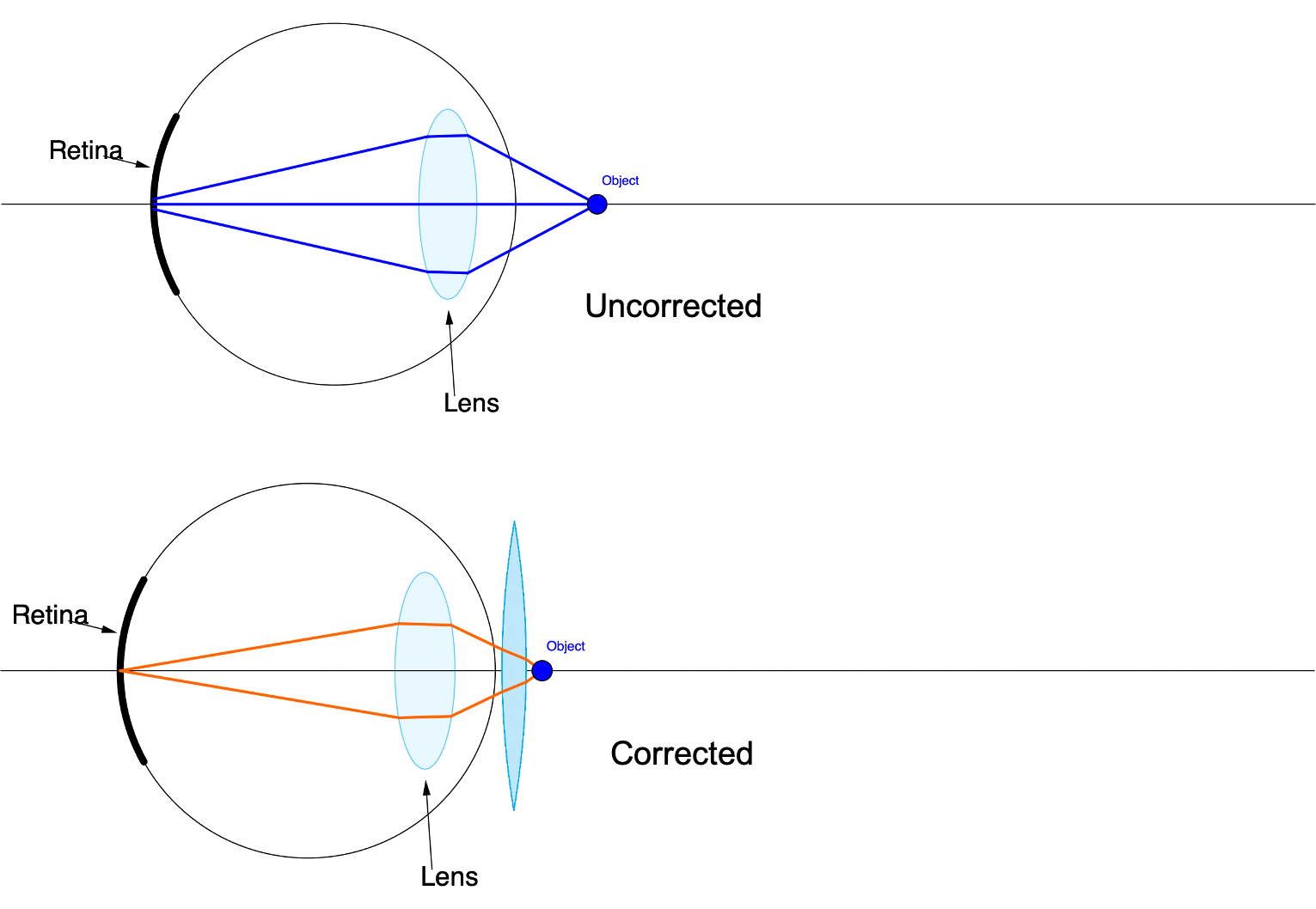
- A virtual, inverted and magnified image is formed by the lens system of a compound microscope.
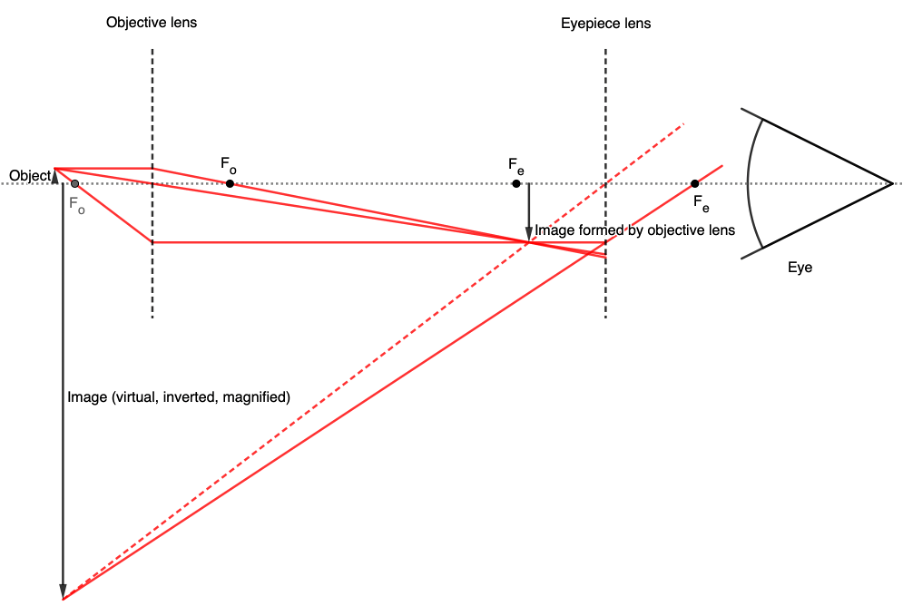
Media Attributions
- figure1 © Sailko is licensed under a CC BY-SA (Attribution ShareAlike) license
- figure2 © Sarah Greenwood is licensed under a CC BY (Attribution) license
- figure3 © Loco Steve is licensed under a CC BY-SA (Attribution ShareAlike) license
- figure4 © Lumen Learning is licensed under a CC BY (Attribution) license
- figure5 © Lumen Learning is licensed under a CC BY (Attribution) license
- figure6 © Lumen Learning is licensed under a CC BY (Attribution) license
- figure7 © Lumen Learning is licensed under a CC BY (Attribution) license
- figure8 © Lumen Learning is licensed under a CC BY (Attribution) license
- figure9 © Lumen Learning is licensed under a CC BY (Attribution) license
- figure10 © Lumen Learning is licensed under a CC BY (Attribution) license
- figure11 © Lumen Learning is licensed under a CC BY (Attribution) license
- figure12 © Lumen Learning is licensed under a CC BY (Attribution) license
- figure13 © Lumen Learning is licensed under a CC BY (Attribution) license
- figure14 © Lumen Learning is licensed under a CC BY (Attribution) license
- figure15 © Lumen Learning is licensed under a CC BY (Attribution) license
- assessmentA1 © Geogebra is licensed under a CC BY-SA (Attribution ShareAlike) license
- assessmentA2 © Geogebra is licensed under a CC BY-SA (Attribution ShareAlike) license
- assessmentA3 © Geogebra is licensed under a CC BY-SA (Attribution ShareAlike) license
polymers are substances or materials consisting of very large molecules or macromolecules, composed of many repeating similar subunits. Polymers can be both natural or man-made.
the sharpness or clarity of vision, hearing or thought.
